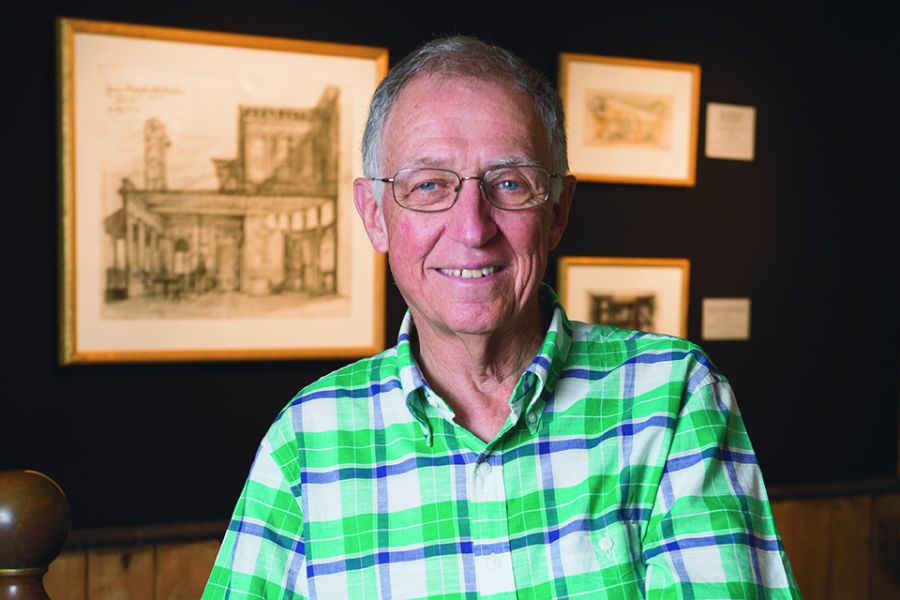Karl Eigsti ’56 completed the circle last July. The Tony Award nominated scene designer brought dozens of paintings, drawings, and photographs to the campus where he first became involved in theater, depicting the sets he created for such iconic productions as Joseph and the Amazing Technicolor Dreamcoat on Broadway and House of Blue Leaves off-Broadway.
His career retrospective had debuted at the New Orleans Superdome in 2002 when the U.S. Institute for Theater Technology honored him with a distinguished achievement award. Last year it was displayed in the refurbished stable at Ewing Manor and a gallery in Centennial East to coincide with the Illinois State Shakespeare Festival. “This exhibition is very meaningful to me,” said Eigsti, “because I went to Metcalf from sixth grade on and then, with the exception of my freshman year, University High School.”
It was at Metcalf that Eigsti attracted the notice of longtime Illinois State Theatre Director Mabel Clare Allen. She cast the sixth-grader in the title role for Rumpelstiltskin in the Children’s Theater of Normal. Later he performed in two of her university productions, My Heart’s in the Highlands and Ernest Hemingway’s The Killers. “I got my start in the theater here, with Mabel Clare Allen,” Eigsti said.
Eigsti performed in plays at University High School and then studied acting at Indiana University. He fell into scene design only by chance. During college he was acting in summer stock theater in Michigan when the set designer quit in the middle of the season. Recognizing Eigsti’s talent for drawing, the director asked him to design the set for Picnic. Eigsti accepted and his life took a new direction. His efforts were rewarded in 1962 with a Fulbright scholarship to study set design in England.
“The theater was undergoing a great transformation at that point in England. I saw literally 100-plus plays in a two-year time, and I also had many design opportunities there,” Eigsti said. Upon his return to the U.S., Eigsti immediately got a job at the famed Arena Stage in Washington, D.C. “I have been a designer ever since,” he said.
For the next 25 years, Eigsti designed 10 to 15 shows a year on average—on Broadway, off-Broadway, and for regional theaters across the United States. In 1979 he earned a Tony Award nomination for Best Scenic Design for the play Knockout. However, out of the 20 shows he designed for Broadway between 1969 and 1984 Grease was the unexpected golden goose of Eigsti’s career.
“In 1970, and 1971, I was out of work for 15 months, and my son had just been born.” he said. “My friend Douglas Schmidt, the set designer for Grease, asked me to do the lighting for this little off-Broadway show that we both thought would only last for a few weeks and never be heard from again.”
In 1972, Grease began a record-setting eight-year run on Broadway. That success helped him afford a larger apartment in New York City and launched his set design career on Broadway for the next 15 years. “That’s the way this business goes,” he said. “One day you are on the verge of re-evaluating your career and your prospects for the future, and then your fortune turns. Of course, one must remember that ‘lucky breaks’ can be defined as ‘opportunity meeting preparation.’”
Following his Broadway design career, Eigsti was asked to be the head of the graduate theater design program at Brandeis University, a position he held for 21 years. “My teaching gave me the opportunity to give to a generation of future theater designers experiences that are not available in books,” he said.
Eigsti has since retired from teaching and returned to New York City. He reconnected with Illinois State early last year when asked to create the set design for the School of Theatre and Dance’s production of the Benjamin Britten opera A Midsummer Night’s Dream. At the time, he mentioned his career retrospective and was offered the opportunity to bring it to the Illinois Shakespeare Festival.
Eigsti spoke about the drawings and paintings of his set designs that were on display. He explained how theater is a collaborative craft involving directors, writers, actors, and producers who cooperate to create a production that results in the most effective live performance in front of an audience. “The thing about theater is that it is alive: It is of the moment, and when it’s over, it disappears,” he said. “Shakespeare observed that the theater is like life, each moment passes and then is gone forever. So all of this work on display at the festival is like an echo of those past live productions. The artwork is present and will last a long time; the production it represents has disappeared forever.”
Eigsti has given his retrospective, The Karl Eigsti Collection of Theater Design, to the Illinois State University Foundation. It is under the direction of archivist April Anderson and will eventually be linked to the Foundation website for all to see.


